Share it
The new Supreme Court encourages visitors to the Court. Those who visit come away with a variety of impressions of the highest court in the land. In this guest post, artist Isobel Williams reflects on her latest visit to the Court.
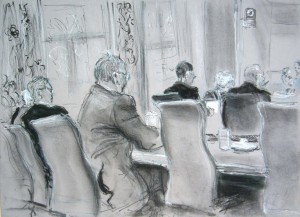 From the public seats it’s about the backs of chairs. Their curves contain Hogarth’s line of grace and beauty (seen on the palette in his self-portrait below). In his book Analysis of Beauty, he argues that sinuosity is more dynamic and gratifying than a straight line.
From the public seats it’s about the backs of chairs. Their curves contain Hogarth’s line of grace and beauty (seen on the palette in his self-portrait below). In his book Analysis of Beauty, he argues that sinuosity is more dynamic and gratifying than a straight line.
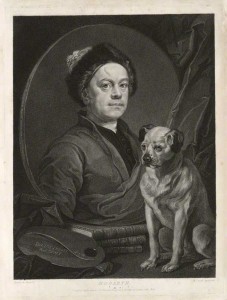
Here in emblematic Court 2, Hayes v Willoughby concerns harassment and examines different kinds of stalkerish behaviour. Howlett v Holding, for instance, involves the overkill of leaflet drops and derogatory remarks trailed behind a light aircraft.
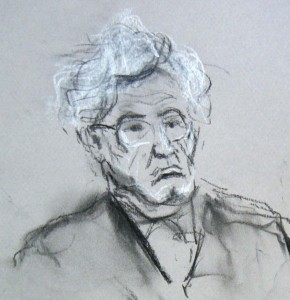
Lord Sumption
In today’s case, a man tried to persuade law enforcement agencies to investigate his former employer. His allegations had no substance. Is the ex-employee shielded because his aim was to prevent or detect crime?
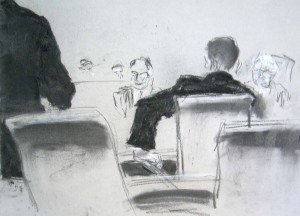
Clive Wolman is congratulated more than once on his performance. But when Robin Allen QC stands up to defend with silky elegance, Wolman’s left arm’s default position is gripping the chair.
Is there a danger that Robin Allen will exceed his time limit? No fear: ‘My lord, I have applied a guillotine to myself.’
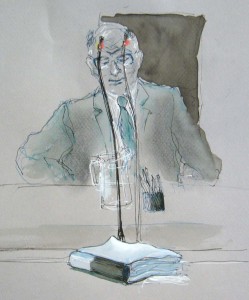
Lord Neuberger and an optical illusion.
I try to examine the optical illusion that creates two desk microphones in the foreground when I look at Lord Neuberger in the background.
Oops. Fleeting eye contact with a law lord. That makes me feel stalkerish. I wish I were invisible. Can they hear the accidental snap of my charcoal from that far away, like an interloper stepping on a twig?
And do they get their own back? I’m told that at least one of the justices sketches during hearings. Which brings me to a fascinating book, The Art of Justice: The Judge’s Perspective by Ruth Herz, herself a former judge in Cologne.
Pierre Cavellat, a judge in Brittany from 1929 to 1969, drew from the bench with the ruthless eye of a gagged social commentator (albeit with a weakness for a pretty face). The book painstakingly examines the emotional, cultural, forensic and aesthetic context of his work. He sees more than he says. I feel it’s time for a Wim Wenders remake: The Judge’s Fear of the Penalty. Which, for Cavellat, included capital punishment.
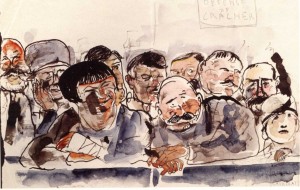 What would Cavellat make of today? I will have to try a Cavellat pastiche next time. Although French and Algerian criminals and Nazi overlords offer a more colourful cast than the Supreme Court on an average day.
What would Cavellat make of today? I will have to try a Cavellat pastiche next time. Although French and Algerian criminals and Nazi overlords offer a more colourful cast than the Supreme Court on an average day.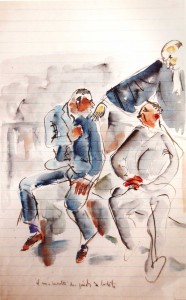
The two illustrations here appear courtesy of All Souls College, Oxford.
Then with a sly, barely audible mechanical sound in my left ear, a tourist behind me photographs my half-done drawing. Twice. I stifle my instinct to turn round and bawl her out. And no, photography isn’t allowed.
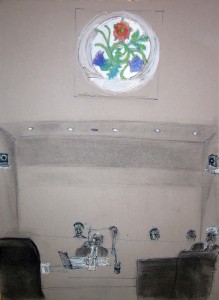
Afterwards in the cafeteria I buy a Supreme Court biro (with easy-grip surface) and a rubber-tipped pencil and, sitting by the merchandise showcase, use them to draw a Supreme Court teddy bear. He is my best sitter here, by far. He keeps still and I can sit just three feet away from him.
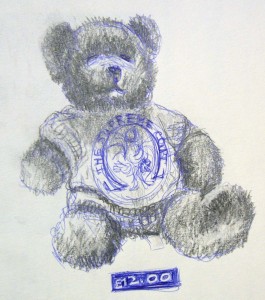
‘Do you work here?’ asks a tourist while I’m sketching.
‘No.’ Although my coat does match the curtains. It’s camouflage.
We can all be stalkers now that Supreme Court judgments are on YouTube. But the ‘Comments’ section has been disabled. That’s not cricket.
 The Art of Justice by Ruth Herz is published by Hart Publishing (ISBN 9781849461276; Sept 2012; £35)
The Art of Justice by Ruth Herz is published by Hart Publishing (ISBN 9781849461276; Sept 2012; £35)



1 comment